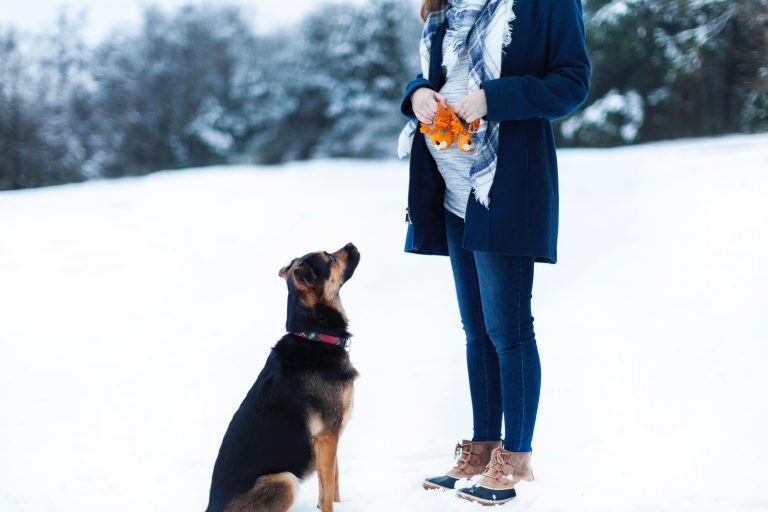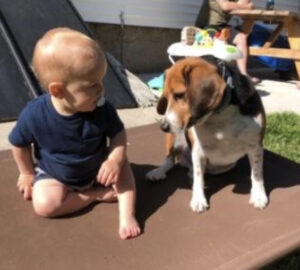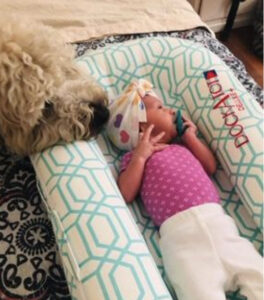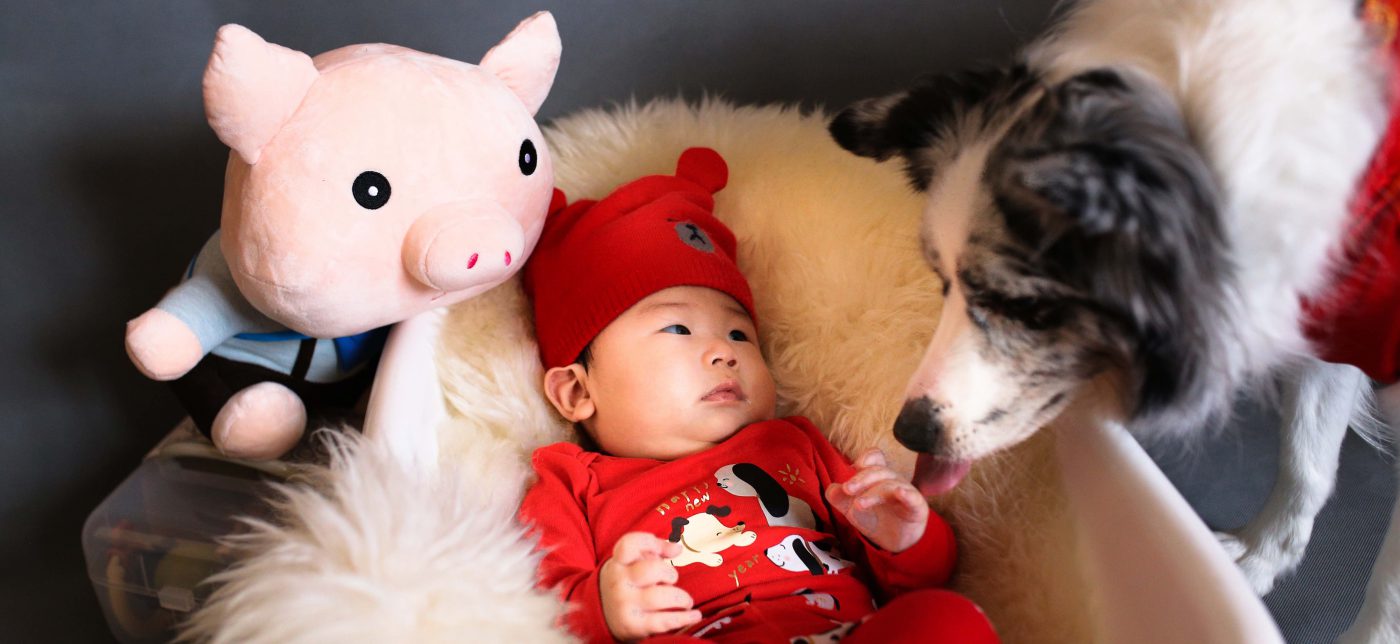- Dogs and kids are a match made in heaven, but it can take some time for the bond to form. Don’t set expectations that the magic will happen immediately.
- Teach or review basic commands before the baby arrives.
- Introduce your dog to new gear, new routines, and new smells before the baby comes home. Encourage calm, positive associations with all these new things.
- When introducing baby and pup, maintain boundaries and let your dog (respectfully) sniff.
- Always supervise your dog and baby when they’re together.
Preparing for a new baby is a whole job in itself. There’s the books to read, the gear to research, buy, and assemble, the doctor appointments, insurance calls—the list goes on. Thankfully you have nine months—give or take a few weeks—to get as ready as you can for that tiny new addition.
And while you’re in the midst of baby prep, your dog may be blissfully unaware that their world is about to change. That’s not to say that they won’t still love their life. It’s just that any kind of a change can be rough on a pet. And when it comes to welcoming a newborn into the family, that change can literally feel like it’s happening overnight for your dog.
It’s true that dogs and babies can take to each other immediately; for some this happens without any real preparation. But that Instagram-ready scenario is not as common as you think. There are some things you can do, though, to help ease the transition for your pet, your baby, and you—and set your dog and your kid up for a forever friendship.
Here, we’ll run through tips from experts and stories from parents who have been there themselves.
BEFORE BABY
Take advantage of the time leading up to your baby’s arrival to brush up on some basic commands and make gradual adjustments to your living space and daily routines.

Review, or teach some basic commands
Once your baby arrives, your hands will be quite literally full. So, it will be extremely helpful if your dog can understand basic cues without you having to get physically involved. Dominika Knossalla, certified dog trainer and the co-founder of Dog Meets Baby, recommends brushing up on or teaching these basic commands:
- Go to cue (teaching your dog to go to a certain location)
- Away (teaching your dog to move away from you and the baby or area)
- On/Off
- Leave it
- Stay
- Drop
- Up and down (if you have stairs inside your home, make sure to teach your dog to go up and down the stairs before you. And “stay” to prevent tripping or knocking you over when you are carrying your baby)
As a mom to four-year-old twins and a lab, Lola, Knossalla speaks from experience when she says that you should practice these cues in many different situations, especially for specific future scenarios with your baby.
Review relationship fundamentals
Remember that training is an ongoing process of developing a strong relationship with your dog. Beyond specific commands, consider working with a trainer, and put the time in to develop boundaries, and a respectful daily dynamic between your dog and your human family. “I want to teach all dogs to be respectful of the baby, the space around the baby, and when the baby is around in general,” says trainer and founder of Dream Come True K9, Blake Rodriguez. “But that typically starts with a dog that is asked this routinely from the adults—with or without the baby.” With that groundwork, introducing a new family member will be a happier experience. Your dog will be familiar with the concept of giving space when required, and you can more easily teach your dog the behavior you expect around your baby.
Encourage calm, positive associations
Dogs learn by association, so training involving your dog’s emotions is important. “Dogs are constantly making associations between things and these associations determine how they feel about their world and everything in it,” says Knossalla.
Ensure that everything to do with the baby is associated with calm, and with good things, instead of disruption, deprivation, and agitation.
You may have heard the tip to bring a blanket or other item that contains your baby’s scent home from the hospital ahead of the baby’s arrival. If that’s possible, by all means do it (some parents may find it hard to manage this logistically). Allow your dog to respectfully sniff (not maul) the item, and then offer praise. You may also want to expose your pup to some of the other baby items that have a unique smell, and similarly establish a positive association.
“Changes in the house setup and baby equipment (especially gear that moves and makes sounds) may negatively impact the dog if not introduced in a thoughtful way,” Knossalla says. Once your house setup is complete, introduce musical toys, baby furniture and the various baby items one at a time.
Just as a baby’s shriek can be piercing for humans, it can also be upsetting for some dogs (and some dogs may not be bothered at all). To get your dog accustomed to a baby’s cry, consider using some of the same techniques that can help prevent fireworks-phobia in dogs—play audio recordings of the sound at low volumes and offer treats. Slowly increase the volume if the dog is tolerating the noise until they can calmly handle a typical volume.
Make changes to your environment and routine in advance
“Dogs are very sensitive to environmental changes and moveable objects, including anything that changes the human form,” says Jessica Gore, animal behaviorist and certified professional dog trainer, and founder of Competent Pup. “Your pup may be curious or fearful about all this new baby stuff, so be sure to get them used to it well in advance.”
Some dogs are very sensitive to these changes, while others don’t care at all, but in this case it’s better to be safe than sorry. Ideally, the baby should be the only sudden change in the dog’s life. Implementation of new routines, introduction to the baby equipment and changes in the house configuration should happen before the new family member comes home. “The point of bringing in the equipment in advance is to give the dog time to acclimate and feel comfortable with items that could potentially be scary,” says Knossalla.
If your dog’s sleeping arrangement is going to change, make the adjustment before the baby arrives. Even exposure to other infants, if possible, can be helpful. This way your newborn is not the first little human your dog meets.
You may even want to take your dog for some walks with your stroller. They can get used to having it wheeled by them and you can practice how best to juggle the leash while pushing it.
If you know that you won’t have enough support to maintain the same level of attention you give your dog now, start spending less one-on-one time with them before the baby arrives (ideally recruiting another family member or friend to pick up the slack). This way, they won’t necessarily associate your lack of attention with the baby. Help them find new forms of entertainment. Interactive toys can help keep dogs busy without you having to toss a ball or tug at a toy. And having a regular dog walker come by can be a great source of attention and exercise for pets.
Don’t set unrealistic expectations

River and Buddy
It’s easy for us to fantasize about the moment our pets and baby will meet, and to imagine them bonding with each other immediately and forming a lifelong friendship. And while that kind of relationship is entirely possible, you should not expect it to happen overnight.
Sydney Bower, mom of one-year-old River and owner of Scrappy (a chihuahua mix) and Buddy (a beagle) shares her experience:
“To be honest, introducing my newborn son to my two pups never crossed my mind when I was pregnant. I think it was something I assumed would just happen and be fine. They would automatically be the best of friends and have a relationship like I see on social media. You know, the ones where the baby just lays on the dog and the dog loves it? No. Not my experience.”
While Bower’s dog Buddy greeted the newborn she carried in with a happy dance, Scrappy, her older pet gave the baby’s feet one sniff and walked away. “He wasn’t excited and actually seemed a little upset.” As the days went on both dogs kept their distance. “They never really got near the baby and would leave the room when he would cry. The baby was taking a ton of attention (as expected) and the pups felt that.”
DOG MEETS BABY
Don’t “force the meet”
One important thing to keep in mind is that there’s no rush to introduce your dog the minute the baby comes home (as tempting as that may be).
You can keep your dog completely separate with a gate or in a different part of the house from the baby for a few days, or longer. You may have to focus on your baby exclusively or you may wish to acclimate your dog to the baby’s scent in the house. “It’s perfectly okay not to initiate contact at first,” says Knossalla. “During this time your dog will be able to observe and smell the baby from a distance.”
We tend to think of the first-meeting moment as what Rodriguez calls “a whole Lion King ceremony.”
“A big mistake that I see people make is ‘forcing the meet,’ by bringing the dog up to the baby or baby up to the dog,” says Rodriguez (who, as a trainer and a dad to human and canine family members, has personal and professional experience in these matters).
Rodriguez recommends thinking beyond the first meeting to the ongoing dynamic between the dog and baby. “The first thing that I look to do is focus on the ideal energy or state of mind that I want my dog or dogs to be in around the baby routinely. I’m looking to set the tone long term,” he says.
The goal is for dogs to learn to feel included but not on top of or in the baby’s personal or intimate space, says Rodriguez. And, again, the baby’s scent should always be associated with calm.
As Rodriguez notes, dogs have about a hundred times the number of olfactory receptors than we do, so they don’t need to directly sniff a baby to know they’re there. “Even with the child not in the room the dog will smell the child on the adult who was holding them previously,” he says. So, even without the baby in your arms, you can instill the desired calm association with the baby’s scent, so when the baby is around, that calm and respect of space is the default.
From here, over time (and depending on the dog it could be later in the day, week or even month after the baby comes home) invite the dog into your space while the baby is in your arms. “This means you as a dog have done the right things and essentially earned the privilege of being closer because you have shown that you understand the rules,” says Rodriguez. “It can be more challenging for dogs to be calm once the baby is closer so I keep the rules the same. You are closer but it’s not about happy or high pitched, excited voices, it’s about maintaining the respectful energy and respect in the presence of the baby. I essentially put the baby on a pedestal.”
Be sure your dog respects the space of the nursery. Some parents choose to keep the nursery off-limits for a period of time after the baby comes home. If so, train your dog before the baby arrives to stay outside the nursery door unless you give them permission to enter. Reward when they observe the boundary, and when they enter and leave the room when you give the command. When you’re ready, invite them in and allow your dog to sniff while holding the baby.
A tired dog is a good dog, baby edition
When it comes to meeting time, if possible, have someone take your dog on a long walk, or give them some other form of exercise to burn energy before the introduction. Exercise can relax your dog and it also releases mood-stabilizing serotonin that can have a calming effect. “Exercise is helpful—the. calmer the dog the better,” says Rodriguez. “In general a dog that doesn’t have pent up energy is always a safe bet. A dog that is content and not expecting much is ideal.”
If you are doing introductions when you arrive home
Say hello to your pet first without the baby: Whether you were away from your dog for one night or five, they’ve missed you. Even if they’ve had some exercise, they may be excited and may jump or bark, which is understandable. Avoid having to correct them by walking in by yourself first and let your partner or support system wait outside with the baby. Then swap so that the other person present has a chance to say hello too.
Claim your space: When it’s time to bring the baby in, be aware of the available physical space around you. Just like when you introduce pets to each other, you want space and control so that physical separation is easy. Small tight spaces, like entryways, aren’t ideal. When you first introduce your dog and your baby, be sure that your dog is being invited by you into the baby’s space, and that they don’t jump up or bound toward you and the baby. “Management is key,” notes Gore. During the first meeting consider keeping your dog on a loose leash. When the dog is calm and relaxed, approach the other person holding the baby.
AFTER THE BABY IS HOME
Keep up with routines
 It won’t be easy all of the time, but try to mirror the same amount of attention your pet would typically get. “I basically never changed the way I treated Charley,” says Ashley Burdette, mom to one-year-old Coralie and owner of Charley (wheaten terrier). “I still took Charley on our daily walks, a little slower, but I kept the routine, and took her to the dog run in our neighborhood.”
It won’t be easy all of the time, but try to mirror the same amount of attention your pet would typically get. “I basically never changed the way I treated Charley,” says Ashley Burdette, mom to one-year-old Coralie and owner of Charley (wheaten terrier). “I still took Charley on our daily walks, a little slower, but I kept the routine, and took her to the dog run in our neighborhood.”
“They’ve been nothing but besties. Charley lets Coralie do what she wants to do and Coralie loves Charley, but maybe not the licking. I know other people are very hesitant and want to take a lot of precautions, but I tried to treat Charley with the same love I always did.”
Stanley Germain says when he and his wife Jessica brought their baby home, he made sure to pick up the slack on an important part of their lab Pearl’s daily routine. “There was very little change in routine,” he says. “Pearl was conditioned to play fetch until exhaustion each morning before breakfast. As long as we kept playing fetch, the rest of the day was easy. I took these duties over following the birth of our son.”
Keep in mind that not all pets will react the same or follow a prescribed timeline. Multi-pet households will see this firsthand, with one pet gravitating toward the baby and the other perhaps ignoring the baby altogether. No matter, you can help your pet and baby bond, with time, patience and the same amount of love you’ve always given them.
If your dog is fearful, help them work through it
Gore points out that, “It is not uncommon for pups to find small children scary, especially when they become more mobile.” Some dogs may not be socialized to babies or have much experience with them at all, which can lead to a natural, fearful response. If your pet seems excessively fearful of your baby, she suggests that you hire a certified professional trainer who can work with counter-conditioning and desensitization exercises.
Always supervise when they’re together
The truth is, your pet could unintentionally harm your baby, even if they love each other from the start. Really, your pet may be even more prone to cause an accident if they always want to be around the baby. They might not realize their own strength and their curiosity might get the better of them. So unless you’re using a pet gate, always stay alert when they’re together.
Follow your pet’s lead and encourage their interest
“New parents may find that their pup is hanging around during meals, bath time, tummy time, story time, naps or other activities. These could be the baby experiences that your pup is most receptive to,” notes Gore. Parents can further capitalize on this with a reward system, like praise or a toy.
New parents can observe when their pup seems intrigued or willing to participate, give them a task to do, and reward accordingly. It’s important to pay attention to your dog when the baby is awake and this is one great way to acknowledge them both in a positive way.
Germain says when his son first came home, Pearl was curious and a bit standoffish. “She immediately seemed to recognize that the baby was fragile,” he says. “Gradually she began to notice him more. Their bond was strengthened when we began consuming (and dropping) solid foods…”
“Many pups will be content to observe this new, growing human, and benefit from the life enrichment involved from having a new baby around,” says Gore.
Help their bond grow
As Bower recounts, as her baby River grew, Buddy became more interested and would lay next to him, lick him, and be relaxed near him. Scrappy however, was still very distant, would stay in the opposite room and rarely get near River. “We gave him the space and time he needed to adjust,” says Bower, “He’s our old man.”
After a couple of months, Scrappy started warming up. He’d lay next to River, but wouldn’t look at him. Now, a year later, both dogs love River and the free treats he shares from meal-time. The new challenge is teaching River to be gentle and respect the dogs and their boundaries.
And that is the other key part of the dog-baby relationship—once your child is old enough move around and grab things, and understand, make sure that they aren’t pulling ears and tails or otherwise using the dog as a toy, and that they are also learning to respect space. It’s never too early to teach your little one empathy, and about being your dog’s best friend, too.
Photo by Jimmy Conover on Unsplash.









